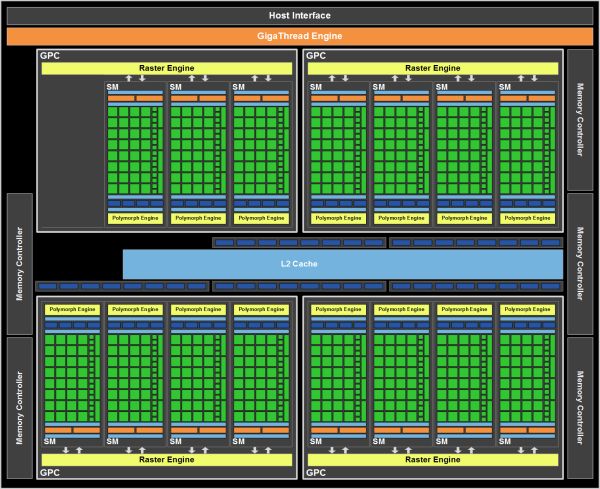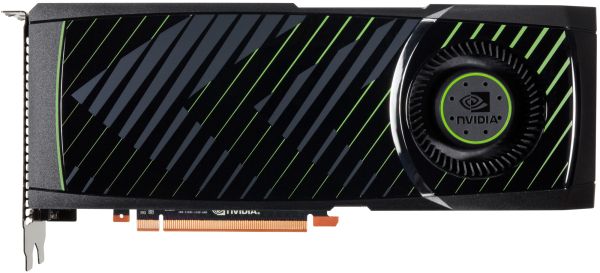NVIDIA's GeForce GTX 570: Filling In The Gaps
by Ryan Smith on December 7, 2010 9:00 AM ESTNVIDIA can be a very predictable company at times. It’s almost unheard of for them to release only a single product based on a high-end GPU, so when they released the excellent GeForce GTX 580 last month we knew it was only a matter of time until additional GTX 500 series cards would join their product lineup.
Now less than a month after the launch of the GTX 580 that time has come. Today NVIDIA is launching the GeForce GTX 570, the second card to utilize their new GF110 GPU. As the spiritual successor to the GTX 470 and very much the literal successor to the GTX 480, the GTX 570 brings the GTX 580’s improvements to a lower priced, lower performing card. Furthermore at $350 it serves to fill in the sizable gap between NVIDIA’s existing GTX 580 and GTX 470 cards.
So how does NVIDIA’s latest and second greatest stack up, and is it a worthy sibling to the GTX 580? Let’s find out.
| GTX 580 | GTX 570 | GTX 480 | GTX 470 | |
| Stream Processors | 512 | 480 | 480 | 448 |
| Texture Address / Filtering | 64/64 | 60/60 | 60/60 | 56/56 |
| ROPs | 48 | 40 | 48 | 40 |
| Core Clock | 772MHz | 732MHz | 700MHz | 607MHz |
| Shader Clock | 1544MHz | 1464MHz | 1401MHz | 1215MHz |
| Memory Clock | 1002MHz (4008MHz data rate) GDDR5 | 950MHz (3800MHz data rate) GDDR5 | 924MHz (3696MHz data rate) GDDR5 | 837MHz (3348MHz data rate) GDDR5 |
| Memory Bus Width | 384-bit | 320-bit | 384-bit | 320-bit |
| Frame Buffer | 1.5GB | 1.25GB | 1.5GB | 1.25GB |
| FP64 | 1/8 FP32 | 1/8 FP32 | 1/8 FP32 | 1/8 FP32 |
| Transistor Count | 3B | 3B | 3B | 3B |
| Manufacturing Process | TSMC 40nm | TSMC 40nm | TSMC 40nm | TSMC 40nm |
| Price Point | $499 | $349 | ~$400 | ~$240 |
The GTX 570 is likely the closest thing we’ll see to a GF110 version of GTX 480 – or any other GF100 card for that matter. With the higher yields afforded by the GF110 design and TSMC’s process improvements, we’ve already seen NVIDIA go for a fully operational GF110 design in the GTX 580, so the GTX 570 works from there. The end result is a melding of the GTX 480’s shader count with the GTX 470’s ROP count and memory bus, and with a clockspeed a bit over GTX 480 and well over GTX 470, performance is much closer to the GTX 480 than the GTX 470.
With 15 of 16 SMs enabled, the GTX 570 matches the GTX 480 at a total of 480 active CUDA Cores and 60 texture units. The core clock is 732MHz, 32MHz (4.5%) over the GTX 480 in order to make up for the reduced ROP/memory blocks and to take advantage of GF110’s lower leakage at higher clocks (as a minor aside, why the strange clocks lately? Look to the PLL). Meanwhile the memory system uses the same 320bit (64bit x 5) memory bus & 10 memory chip configuration we saw on the GTX 470, however this time the memory clock is up to 950MHz (3.8GHz data rate), 113MHz (13.5%) over the GTX 470. Memory clocks are also marginally faster than the GTX 480 by 26MHz, but this isn’t nearly enough to make up for the narrower memory bus. Finally we have the ROPs, which share an existence with both the core and memory subsystems and split the difference – it’s the same 60 ROPs and 640KB of L2 cache as the GTX 470, but because the ROPs run on the core clock they’re running 125MHz (20.5%) faster than the GTX 470.
Since it’s based on GF110, GTX 570 also shares the same architectural enhancements we first saw in the GTX 580. This means GTX 570 can retire twice as many FP16 texels per clock as GTX 480, and it also features NVIDIA’s improved Z-culling system. For the GTX 570 this helps to further close the potential performance gap between the GTX 570 and GTX 480 that results from the lower ROP count and narrower memory bus. Do note however that compared to the GTX 470 the overall improvements are asymmetric: we’re looking at around a 30% theoretical improvement in shading/compute/texture performance, but only a 13.5% improvement in memory bandwidth, so unlike the GTX 580 and its balanced approach, the difference on the GTX 570 is going to be greater on shader-bound games and applications, and lesser when we’re memory bandwidth limited.
As the GTX 470’s successor, the GTX 570 generally fits in the same power and noise profile as the GTX 470. NVIDIA puts the TDP at 219W – a mere 4W over GTX 470 – highlighting the fact that NVIDIA has gone for maximizing performance within their selected power profile for the GTX 570, versus increasing performance but also decreasing power consumption to the GTX 580. The card is otherwise identical to the GTX 580 – the GTX 570 uses the same PCB, the same vapor chamber cooler, and the same shroud as the GTX 580.
NVIDIA is putting the MSRP for the card at $349, a price that in recent weeks has been vacant as neither NVIDIA or AMD had a product to put between the 480/470 and 5970/5870 respectively. Coming from the top-end of the market this is more or less a nice price drop for GTX 480-like performance, but it also means the Radeon 5870 and GTX 470 are the GTX 570’s value threats – the 570’s a good bit faster, but they’re nearly $100 cheaper. The only other competition for the GTX 570 for now will be the GTX 460 1GB SLI and the Radeon HD 6850 CF.
Today’s launch should be a hard launch. Going in to the GTX 580 launch we had our doubts that NVIDIA could have so many GF110 products ready on such short notice, but they were able to prove us wrong there and we’re willing to take them at face value on this. Based on their own estimates and the lower price of the GTX 570 we’d expect some cards to sell out, but availability shouldn’t be an issue.
Finally, with the launch of the GTX 570, NVIDIA’s lineup will be shifting. GF110 is a very effective replacement for GF100 and NVIDIA will be looking to phase out GF100 cards as quickly as they reasonably can. The GTX 470 will still be around for quite some time (all indications are that NVIDIA still has a lot of GF100 chips left) but GTX 480’s days are numbered.
| Winter 2010 Video Card MSRPs | ||
| NVIDIA | Price | AMD |
| $500 | ||
| $470 | Radeon HD 5970 | |
| $410 | ||
| $350 | ||
|
|
$250 | Radeon HD 5870 |
| $240 | Radeon HD 6870 | |
| $180-$190 | Radeon HD 6850 | |












54 Comments
View All Comments
xxtypersxx - Tuesday, December 7, 2010 - link
If this thing can hit 900mhz it changes the price/performance picture entirely, why no overclock coverage in such a comprehensive review?Otherwise great write up as always!
Bhairava - Tuesday, December 7, 2010 - link
Yes good point.vol7ron - Tuesday, December 7, 2010 - link
Why do graphics cards cost more than cpu+mobo these days?I know there's a different design process and maybe there isn't as much an economy of scale, but I'm just thinking about the days when it was reverse.
Klinky1984 - Tuesday, December 7, 2010 - link
Well you're essentially buying a computer on a card with a CPU these days. High performance GPU w/ high performance, pricey ram, all of which needs high quality power components to run. GPUs are now computers inside of computers.lowlymarine - Tuesday, December 7, 2010 - link
I think it's simply that GPUs can't get cheaper to the extent that CPUs have, since the die sizes are so much larger. I certainly wouldn't say they're getting MORE expensive - I paid $370 for my 8800GTS back in early 2007, and $400 for a 6800 in early 2005 before that.DanNeely - Tuesday, December 7, 2010 - link
High end GPU chips are much larger than high end CPUchips nowdays. The GF110 has 3bn transistors. For comparison a quadcore i7 only has 700m, and a 6 core athlon 900m, so you get 3 or 4 times as many CPUs from a wafer as you can GPUs. The quad core Itanic and octo core I7 are both around 2bn transistors but cost more than most gaming rigs for just the chip.GDDR3/5 are also significantly more expensive than the much slower DDR3 used by the rest of the computer.
ET - Tuesday, December 7, 2010 - link
They don't. A Core i7-975 costs way more than any graphics card. A GIGABYTE GA-X58A-UD9 motherboard costs $600 at Newegg.ET - Tuesday, December 7, 2010 - link
Sorry, was short on time. I'll add that you forgot to consider the price of the very fast memory on high end graphics cards.I do agree, though, that a combination of mid-range CPU and board and high end graphics card is cost effective.
mpschan - Wednesday, December 8, 2010 - link
Don't forget that in a graphics card you're getting a larger chip with more processing power, a board for it to run on, AND memory. 1GB+ of ultra fast memory and the tech to get it to work with the GPU is not cheap.So your question needs to factory in cpu+mobo+memory, and even then it does not have the capabilities to process graphics at the needed rate.
Generic processing that is slower at certain tasks will always be cheaper than specialized, faster processing that excels at said task.
slagar - Wednesday, December 8, 2010 - link
High end graphics cards were always very expensive. They're for enthusiasts, not the majority of the market.I think prices have come down for the majority of consumers. Mostly thanks to AMDs moves, budget cards are now highly competitive, and offer acceptable performance in most games with acceptable quality. I think the high end cards just aren't as necessary as they were 'back in the day', but then, maybe I just don't play games as much as I used to. To me, it was always the case that you'd be paying an arm and a leg to have an upper tier card, and that hasn't changed.